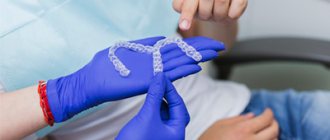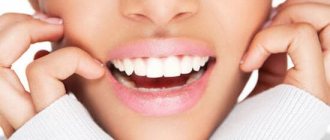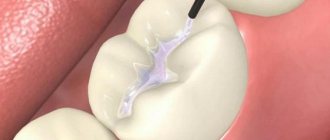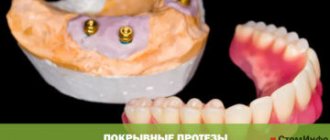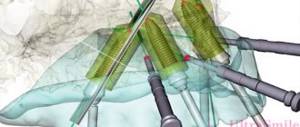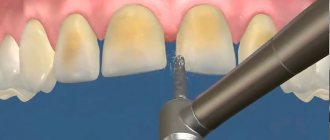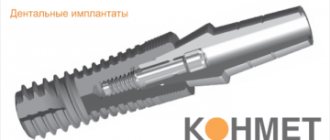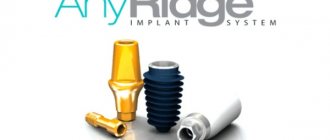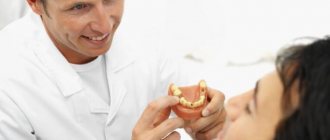Classification of impression materials
Among the many classifications of impression materials, the central position is occupied by the ISO classification, developed by G. Staegemann and R. Phillips in 1991. The classification is simple and is based on the consistency of the material after polymerization and the mechanism of the polymerization reaction itself.
| Hard | Elastic | |
| Irreversible; chemical curing | — Gypsum — Zinc-oxide-eugenol pastes | — Alginate hydrocolloids — Anhydrous elastomers:
|
| Reversible; Thermal curing | — Thermoplastic compounds | — Agar-agar hydrocolloids |
Rigid materials do not have elastic properties after curing and do not restore their original shape after deformation. Elastic materials tend to restore their original shape after exposure to elastic deformations. Elastic deformations are those within which the integrity of the material is maintained, that is, within the elastic modulus.
Some materials harden as a result of chemical reactions and in this case are irreversible, since the polymerization reaction is unidirectional and does not proceed in the opposite direction. Thermoplastic materials have the opposite property. Such materials at a temperature specific to each material acquire plastic properties and harden when cooled.
Gypsum
Medical plaster has found wide application both in dental work and in clinical practice. In dental laboratories, gypsum is consumed in tons per year. Despite such widespread use of gypsum, its use as an impression material is almost completely a thing of the past, and the very fact of its use often surprises young specialists. Gypsum was one of the first impression materials that made it possible to obtain impressions of satisfactory quality. However, in our time it is being replaced from practice by modern impression materials, which are significantly superior to gypsum in terms of quality characteristics. Therefore, many dentists are familiar with the expression V.N., which has already become popular in some circles. Kopeikina: “The use of gypsum as an impression material discredits the title of dentist.” But most dentists, if not themselves, then observed the process of taking impressions with plaster.
Calcium sulfate hemihydrate is used as an impression material, which is obtained by firing natural gypsum, which is calcium sulfate dihydrate. So, at a temperature of 110-130 ℃, calcium sulfate dihydrate decomposes to calcium sulfate hemihydrate, which is many times more soluble in water and precipitates in an aqueous solution in the form of the former calcium sulfate dihydrate.
| CaSO 4 2H 2 O → (CaSO 4 ) 2 H 2 O |
| 110-130℃ |
(CaSO 4 ) 2 H 2 O + 3H 2 O → CaSO 4 2H 2 O + t 0
The process of converting hemihydrate into dihydrate is an exothermic reaction, therefore, when making impressions with plaster, it was split and removed from the oral cavity before it completely hardened. In this way, overheating of the tissues is avoided and the plaster is easier to split.
However, gypsum continues to be used as an impression material. Gypsum has one important property that modern elastic materials cannot achieve - no shrinkage. This property is very valuable in the manufacture of cast structures, when the absence of deformation during removal from the oral cavity and subsequent shrinkage makes it possible to model and cast fixed dentures with excellent accuracy. Therefore, in some budgetary cases, for example, in the manufacture of cast structures in the lateral group of teeth, the use of gypsum may be acceptable and justified. There are also methods for taking impressions from implants using plaster. This allows you to avoid minute changes in the positions of transfers in the impression material. While human teeth have a certain degree of mobility and forgive minor deformations of the impression material, structures on implants have conditional immobility and the slightest changes in the position of the transfers relative to each other in the impression can cause unsatisfactory design of the prosthesis in the future.
| It is possible to remove plaster impressions from the oral cavity without breaking them only in the case of toothless jaws and in the absence of pronounced undercuts of the alveolar process |
Production
The raw material for alginates is usually brown algae, which are extremely common in the world's oceans and can grow up to several centimeters daily. To remove alginic acid, the algae is first dried and crushed, then washed and left to swell in an acidic environment. The next stage is the extraction of alginates from swollen algae. To do this, caustic soda is added to the substance. After clarification and fiber removal, laboratory technicians receive an aqueous solution of sodium alginate. As a result of subsequent manipulations, scientists achieve so-called “acid precipitation” and obtain pure algal acid.
Zinc oxide eugenol impression materials
Polymerization of zinc-oxide-eugenol (ZOE) both impression materials and dental cements occurs as a result of the interaction of eugenol and zinc oxide. Eugenol is characterized by an irritating effect on the human body, therefore the tube with zinc oxide contains mineral oils that eliminate this effect of the material. In addition to these additives, the composition of the tube with eugenol includes fillers such as talc, chalk, kaolin, which provide the necessary consistency of the material, add convenience during mixing, and help reduce shrinkage of the material during polymerization. Mineral salts and rosin accelerate the process of polymerization and hardening of the material.
Zinc-oxide-eugenol impression materials are highly accurate and are capable of reproducing relief elements measuring 50 microns. The material also has extremely low shrinkage, which is within 0.15%. However, the material is rigid and breaks when deformed when making an impression. Therefore, the material has a rather narrow scope of application, which is limited mainly to taking functional impressions from edentulous jaws, the alveolar process of which does not have pronounced undercuts and the material will not be deformed or distorted during removal. In addition, the material is used to register occlusion.
| Zinc oxide eugenol impression material Repin with a clove oil smell characteristic of the entire group of materials |
Reviews
The variety of impression materials allows you to choose exactly the composition that, in terms of indicators and properties, is suitable for creating an impression in a particular case.
If you have your own experience in using the listed materials in dental orthopedics, we will be glad to see your feedback.
If you find an error, please select a piece of text and press Ctrl+Enter.
Tags: fixed dentures, impression materials
Did you like the article? stay tuned
No comments yet
Thermoplastic compounds
The very name of thermoplastic compounds widely reveals the essence of these materials - it is a composition of substances that form a single mass, which, when heated, becomes plastic, can change its shape and hardens in this state when the temperature drops. And the fact that upon repeated heating this mass will again acquire the property of plasticity and determines its reversibility.
Classic thermoplastic compounds include rosin, talc, paraffin, ceresin, zinc oxide, as well as dyes and plasticizers to give the material the desired consistency at the plasticity stage.
The material is softened in a water bath at a temperature of 60-70 ℃, shaped and placed in an impression tray and applied to the tissue of the prosthetic bed, where it hardens at the temperature of the oral cavity. Therefore, the composition is selected in such a way that at a temperature of 37℃ the material completely hardens and does not deform during removal. However, the fact that the material does not deform is the main disadvantage that has limited the scope of application of thermoplastics. In addition, the material does not have the ability to accurately display terrain and does not maintain its spatial stability under environmental conditions.
Based on this, the material is used more as an auxiliary material for obtaining impressions, rather than as a main one, the role of which goes to more advanced materials. Thermoplastics can be used to record occlusion, which is also convenient because the material comes in sheet form. In addition, the material is convenient for the functional design of the edges of individual trays, which is an important condition for successful removable prosthetics.
| Release form of thermoplastic compounds | The material is softened in a water bath |
| Due to the low accuracy and final hardness, its scope of application is limited to registration of occlusion, functional design of impression edges and impressions of edentulous jaws | |
Elastic impression materials
The oral cavity has very thin and elegant shapes, smooth transitions give way to sharp angles, and, open to the eye, hides many secrets, and it is the impression materials that have the opportunity to demonstrate this to us. It is what is hidden, every natural narrowing, thin space between the teeth, the cervical and subgingival areas that are of greatest interest for successful prosthetics, which can be irretrievably lost due to irreversible deformations of the impression materials. This is the reason why elastic materials occupy the main place in the world of impression materials, almost completely displacing “hard” representatives, and offer their alternatives in full.
Agar impression materials
Agar impression materials are also called reversible hydrocolloid or simply agar hydrocolloid in comparison with the irreversible hydrocolloid alginate.
Agar-agar is a mixture of polysaccharides obtained from seaweed, which, when combined with water, forms the same hydrocolloid. Such a compound has a gel structure, formed as a result of a large number of hydrogen bonds, which are destroyed at a relatively low temperature, which is not capable of causing the destruction of the polymer. When heated, hydrogen bonds are destroyed and the gel turns into a sol, which is a viscous liquid convenient for use as an impression material. Upon subsequent cooling at the temperature of the oral cavity, the material again acquires a gel structure while maintaining the newly obtained spatial structure.
The material comes in various viscosities, packaged in tubes, and more fluid materials are available in syringes for convenient use in the gingival area.
Thermal transformations that are used when manipulating agar can burn the patient, so careful work is required and maintaining the optimal temperature of the material for the work and the patient. To do this, the material is first placed in a boiling water bath to quickly liquefy the materials. It is important not to overheat the material and not cause destruction of the polymer. Next, the material is transferred to a second water bath with a temperature of 60-70℃ to maintain the viscosity of the material. After this, the material is placed in a special impression tray with a water heating and cooling system, which is at a temperature that is not capable of causing a burn to the soft tissues of the oral cavity, but provides sufficient working time for the material.
Agar materials can be used in conditions of high humidity without distorting the impression, that is, in conditions of the gingival sulcus. The materials have high accuracy in displaying the relief and do not cause inconvenience when casting models. In addition, the materials taste good and do not leave permanent stains on clothes.
However, along with important positive qualities, the use of the material requires expensive equipment, such as special water-cooled trays, as well as a humidor for storing prints in high humidity conditions.
The material is not able to maintain its spatial stability for a long time, which makes it necessary to cast models no later than 15 minutes after taking impressions. But given that prints need time to recover from deformation, such requirements significantly reduce the quality of the print.
Along with this, low strength and low elastic memory can lead to irreversible deformations when removing impressions from the oral cavity.
general characteristics
Laminaria (seaweed) has many beneficial properties for humans. And not least due to the presence of alginic acid in its composition. Another name for the acid is algal acid, since it was found in green, brown and red marine plants. And what’s interesting is that almost a quarter of kelp consists of this substance. This gel-like substance gives the algae their “jelly bodies” and flexibility.
Alginic acid has many unique properties. One of them is exceptionally high water absorption. Only 1 g of the substance is capable of absorbing about 300 ml of liquid. On the other hand, it is almost 14 times higher than the adhesive ability of starch. And gum arabic in this regard is 37 times worse than alginates. The acid does not dissolve in water or other organic liquids. It is a heteropolymer substance created from the remains of polyuronic substances.
In 1883, British researcher and pharmacist E. Stanford discovered this substance while studying kelp. The scientist concluded that a unique acid structure is formed in algae during the process of biosynthesis. And it is worth noting that in different countries and in different parts of the World Ocean, the composition of alginic acid in plants may differ slightly. This is explained by the natural effects and proportions of D-mannuric and L-hyaluric acids contained in alginates.
Alginates (acid salts), when entering the human body, are not broken down and are excreted from it in an undigested form. This property is reminiscent of the functions of fiber. But alginates are more effective. Thanks to their ability to absorb liquid, algal acid salts remove radionuclides and heavy metals from the body. The experiment showed that algal acid could bind and remove approximately 90 percent of the cesium and strontium. Therefore, drugs containing acid or its salts are considered the best remedies against radiation.
Alginate impression materials
Alginate impression materials have taken a very strong position in the clinic of orthopedic dentistry, in particular in removable prosthetics, as well as in the manufacture of orthodontic appliances. The fact is that it is alginate materials, despite their shortcomings, that are capable of imaging the soft tissues of the oral cavity over a large area. It is alginates that are able to fully display the transitional fold, frenulum and other natural folds and relief of the mucosa, which is extremely important in the manufacture of prostheses or devices that are in direct contact with the oral mucosa over a large area. Such prostheses include complete and partial plate dentures and clasp dentures, as well as various orthodontic appliances. In addition, removable prosthetics in orthopedic dentistry are often low-cost prosthetics, often for older people, and given the low cost of alginate impression materials, their use has a beneficial effect on patient comfort
Alginate impression material is available in powder form, packaged in bags or jars. The powder consists of sodium and potassium salts of alginic acid, which is obtained from seaweed, mainly Laminaria, and calcium salts, most often calcium sulfate, which when mixed with water form an irreversible gel. The gel remains a gel until the water in its composition evaporates and turns the material into a hard and brittle mass. To preserve water in the mass for a long time, the powder also contains inhibitors, which are some sodium and potassium salts. To give the material the required consistency, talc, zinc oxide and other fillers are also added to the powder.
The material is mixed with a metal or plastic spatula in a rubber flask. Using special measuring cups, pour the required amount of powder into the flask, and then add the appropriate amount of water and mix thoroughly. The flask is placed sideways on the palm of your hand and the powder and water are “rubbed” into the wall using figure-of-eight movements. Correct execution of this manipulation will ensure a homogeneous consistency of the material, since even experienced dentists cannot always mix the material uniformly and without lumps, which will directly affect the quality of the impression and the model cast on it. To facilitate the doctor’s work, there are special systems for automatically mixing the material, but again, alginate impression materials are often used for budget prosthetics and such systems are not always justified.
Also, the curing time of alginates is quite sensitive to water temperature. Water at room temperature is considered optimal, that is, approximately 22℃, at which the material will harden in 3-4 minutes, and changing the temperature by one degree up or down can speed up or slow down the gelling time by about 20 seconds, respectively.
Impressions obtained with alginate impression materials are quite accurate, which is determined by the reproduction of relief details measuring 50 microns. Such impressions recover well after deformation and are easily separated from the model material.
But in the process of further reactions occurring in the material after removal from the oral cavity, reaction by-products are released, such as water, acids, and other particles, which affect the hardening process of gypsum and its surface structure, which does not allow obtaining a smooth surface of plaster models . This property sharply limits the scope of application of the material and does not allow the material to be used in the manufacture of fixed prosthetic structures.
However, the most important feature of alginate impression materials is, unfortunately, their negative property - spatial instability. Alginates are very sensitive to dryness or, conversely, humidity. When storing the print both in open conditions and in water, shrinkage and swelling respectively exceed the maximum permissible value of 0.3%. This requires casting models within 15 minutes after the impression is removed from the oral cavity, which also affects its recovery after deformation and the quality of the resulting model. Therefore, if there is a possible longer delay before receiving the models, the print must be placed in a sealed bag, within which changes in the dimensions of the material will be within acceptable limits.
| Ypeen and Hydrogum materials are the most popular alginate impression materials |
Concept and definition
The compositions that are used to obtain an impression are called impression compounds. To be more precise, an impression or cast is a negative reflection of the tissues and relief surface of the oral cavity or the area that requires prosthetics.
If a print is made using thermoplastic mixtures, it is called an impression. If the same procedure is performed using impression materials, then it is a cast.
When the development of orthopedic dentistry was just beginning, beeswax was used for impressions. Even then, the properties of the raw material did not satisfy doctors, since the possibility of obtaining a sufficiently clear image of the relief of the oral cavity was reduced to zero.
Because of this, beeswax began to be replaced with clay, gypsum and gutta-percha . The highest quality casts at that time could be made from plaster.
Today, formulations of different compositions and qualities are used. The list is represented by at least 7 groups of materials. Each group includes at least 3 members.
To understand their properties, it is necessary to characterize each group separately. In addition, in order to obtain a high-quality impression or impression, the composition must meet a number of requirements.
Elastomeric impression materials
Materials from the group of elastomeric impression materials are among the most progressive among all materials, and the fact that manufacturing companies direct their main efforts specifically to improving this group of impression materials is both an indicator of the high class of materials, and a consequence of this, to achieve maximum results and competition in the industry. advanced levels.
The group of elastic materials consists of four more types of materials:
- Polysulfide impression materials;
- Silicone impression materials of condensed type (C-type);
- Silicone impression materials of connecting type (A-type);
- Polyester impression materials.
This separation of materials is based on the difference in chemical composition and polymerization reactions.
In addition, elastomeric impression materials are divided into degrees of viscosity:
- Type 0 – very high viscosity ( Putty );
- Type 1 – high viscosity ( H igh);
- Type 2 – medium viscosity ( M edium);
- Type 3 – low viscosity ( L ow).
Separation of materials by viscosity helps to obtain both highly accurate and durable impressions, thanks to two-phase impression techniques and the use of individual trays.
Polysulfide impression materials
When lead dioxide is added to the polysulfide polymer, which is the main component of polysulfide impression materials, the reaction of further polymerization and hardening of the material is initiated. This process is called vulcanization.
Polysulfide impression materials have extremely high elasticity and, as a result, high tensile strength, which on the one hand makes it possible to obtain impressions of very high quality, however, due to such final elasticity and insufficient hardness, the degree of deformation of the material and models, despite high accuracy, are not able to display the real picture of the relief of the tissues of the prosthetic bed.
In addition, the materials are hydrophobic, which requires keeping the tissues of the prosthetic bed dry. The materials are not characterized by long-term spatial stability, which requires obtaining models as soon as possible after taking the impression, which adversely affects the degree of recovery of the material after deformation, which is especially important for the group of elastomeric impression materials.
Condensed type silicone impression materials (C-type)
The polymerization reaction of condensed silicone impression materials is based on the interaction of dimethylsiloxane with acrylic silicates, releasing a reaction by-product in the form of ethyl alcohol.
The form of release of the material depends on the degree of viscosity of the material: base pastes of materials of 0 and 1 viscosity types are produced in cans, materials of 2 and 3 types are packaged in tubes, and the catalyst in tubes is common for all types of viscosity from one manufacturer. Unlike silicone impression materials of the attachment type, C-type materials are not produced in forms for automatic mixing, since from a marketing and financial point of view this is unprofitable and unreasonable due to the fact that A-type materials are more advanced and much more expensive, while While C-silicones are used in more budget-friendly work, the extra costs for automatic mixing will be inappropriate.
C-type silicones have high tensile strength and sufficient hardness, which has a positive effect on the display of small and important relief details, such as the preparation boundary. A high degree of recovery after deformation, versatility and low price determine the widespread use of materials in the clinic of fixed prosthetics.
However, the materials are hydrophobic and high-quality impressions made from such materials require keeping the tissues of the prosthetic bed dry. A significant drawback is the spatial instability caused by the release of a by-product of the polymerization reaction (ethyl alcohol) and shrinkage, which in a short time exceeds the permissible values and requires rapid casting of models, which directly affects their reliability due to the insufficient degree of restoration of the impression after deformation.
| Zetaplus - C-type base silicone material and Oranwash C-type corrective silicone have a common catalyst - Indurent gel |
Polyester impression materials
The basis of polyester materials is the polyester polymer on the base paste side and the alkyl contained in the catalyst paste and initiating the polymerization reaction.
Polyester impression materials have high dimensional stability, and the stiffness of the material increases over time, making them more suitable for taking impressions of implants. In addition, a long working time, which is then replaced by a sharp hardening, is again convenient for taking impressions from implants, since some manipulations with implants are long and the long-term viscosity of the material contributes to quiet work without fear of premature hardening of the material, which occurs relatively abruptly, which is again convenient for the doctor and the patient.
Long-term storage of material without changing the spatial structure allows one to obtain delayed models and fully use the property of elastic memory.
Also, polyesters have thixotropy, which makes them more fluid under pressure and allows you to display small relief elements. Sufficiently high hydrophilicity forgives moisture in the tissues of the prosthetic bed without reducing the quality of the impression.
High-rigidity materials are quite hard after hardening, which can cause fractures of weakened teeth or dislocations due to periodontal diseases. To avoid such complications, it is important to isolate severe undercuts using low-viscosity materials.
However, all these advantages of polyester impression materials come at a price, which results in the high cost of such materials.
| Impregum material in tubes for automatic mixing in the Pentamix apparatus | Pentamix 3 device for automatic mixing of impression materials |
Silicone impression materials of connecting type (A-type)
Along with polyesters, silicone materials of the connecting type are among the most advanced impression materials, which is the reason for their increasingly widespread use in clinical practice and the desire to almost completely replace other materials in the clinic of modern dentistry.
Unlike C-silicones, the polymerization reaction of addition-type silicone is not accompanied by the release of reaction by-products, which avoids the main disadvantage of the first - shrinkage, which goes beyond acceptable limits in a relatively short time. The high class of the material also determines its high cost, which is justified by the high quality of the print and the final design as a whole.
The impression material has a high accuracy of relief display, good wettability and elasticity, which is maintained by the necessary hardness when using techniques for obtaining two-phase impressions. Pleasant color, taste and smell are convenient, first of all, for the patient, and the introduction of automatic mixing systems brings convenience to the doctor. In addition to the standard form of release in plastic jars and tubes, together with polyesters, A-silicones are produced in special cartridges for automatic mixing using special devices for materials of viscosity types 0 and 1 and dispensers for viscosity types 2 and 3, which is convenient for accurately applying impression material to the gingival tissue area and border of preparation.
However, some materials in this group are hydrophobic, which requires ensuring the field is dry. When mixing the material, you cannot use latex gloves, which is dictated by the property of latex to inhibit the polymerization reaction of such a material.
| Elite HD+ A-type silicone base material for manual mixing | Corrective silicone material A-type Elite HD+ for automatic mixing |
| The automatic mixing dispenser forces material from specially designed tubes into the mixing tip |
The article was written by N.A. Sokolov. especially for the OHI-S.COM website. Please, when copying material, do not forget to provide a link to the current page.
Beneficial features
Alginic acid is an effective antioxidant and a means of cleansing the body of toxins and heavy metals.
Also indispensable for intoxication.
For the cardiovascular system, the benefits of acid include lowering blood pressure and bad cholesterol levels. Possessing antimicrobial and antiviral properties, it protects the body from harmful microflora, fungi and bacilli. In addition, alginates reduce pain during spasms and reduce the risk of allergies.
Why does a person need
Preparations containing alginic acid are used to treat a wide variety of disorders and disorders. The most common reasons for intensive consumption of algae:
- atherosclerosis;
- slagging of the body;
- weak immunity;
- skin diseases;
- increased pigmentation;
- cellulite;
- cardiac diseases;
- intoxication.
But although algal acid is very useful for humans, there are cases when it is better not to abuse this substance. Among the most compelling reasons to avoid nori, kelp or red caviar:
- vitamin deficiency (there is an opinion that it interferes with the absorption of certain vitamins);
- pregnancy;
- liver diseases;
- thyroid dysfunction;
- frequent digestive disorders;
- malignant formations.
Use in the food industry
Alginic acid and its salts (alginates) are not new ingredients in the food industry. At least 5 E-shek on food labels indicate this. The acid itself is listed in the list of ingredients as E400. Its salts are located under the “names” E401, E402 and E404. The food additive agar-agar, created from algae, is designated by the number 406.
In products, “algae” additives play the role of thickeners and are also used to create false red caviar. But when baking bread, the use of E400 prevents the finished product from quickly becoming stale.
Deficiency or excess: how to understand
Since the body is not able to independently produce alginic acid, the substance enters the human body only from the outside: with food, dietary supplements, and medications. Recently, preparations based on kelp, spirulina and other acid-rich plants have become especially popular. Weakened immunity, a high tendency to allergies, poisoning - these are precisely the signs by which one can understand that the body is asking for “feeding” in the form of algae products.
Natural remedies rarely cause side effects or overdose. But if, while consuming alginic acid, nausea appears, the functioning of the digestive system is disrupted, the skin turns red and begins to itch, it is better to discontinue the drug and consult a doctor.
Benefits for the digestive system
Most often, doctors use the ability of alginic acid to draw in liquid to stop internal bleeding, including peptic ulcers. In addition, alginates reduce the aggressiveness of gastric juice and accelerate the healing of wounds on the mucous membranes of the gastrointestinal tract. Once in the digestive organs, algal acid salts acquire a jelly-like consistency and create an additional protective cover.
Having a sorbing effect, alginates remove breakdown products of proteins, carbohydrates, lipids, radionucleids and other harmful substances from the gastrointestinal tract, and neutralize elements that impede the development of proper intestinal microflora.
Researchers claim that alginic acid can displace Candida, staphylococcus and other pathogenic fungi and viruses from the body. Even in small doses, alginates act on the body as an antimicrobial agent.
The popularity of using algal acid salts is explained by their properties. They are non-toxic and quickly leave the body (up to 48 hours), do not disrupt the salt balance of the body, and also do not affect the hydrogen sulfide contained in the intestines for normal peristalsis.
Advantages of artificial crowns:
Advantages of artificial crowns
- Increasing the physical and mechanical characteristics of the crown of a natural tooth due to the circular coverage of the dental stump with a solid structure;
- The ability to reproduce or correct the appearance of the crown in the desired direction;
- The ability to perform the function of a supporting element of a fixed or removable prosthesis.
If all conditions are met, the possible disadvantages of this design (for example, bleeding, temporary whitening or a feeling of pressure in the area of the adjacent gum) are mild or completely absent. However, it should be understood that while performing a restorative and, to a certain extent, preventive function, orthopedic treatment does not affect the main cause of caries - the acid produced by plaque microorganisms. This means that daily personal oral hygiene measures must be carried out in full.
Each type of crown is characterized by its own manufacturing technology: metal ones are cast or stamped, plastic and composite ones are polymerized, ceramic ones are sintered, pressed, milled. Those previously used (stamped with plastic lining, partial, metal-plastic) are now rarely used. Despite this circumstance, at the present stage of development there is a sufficient variety of options to find the optimal solution in each case.
The choice of material and technology depends on the objectives of the individual clinical situation.
Application in medicine
Due to its ability to absorb water, algal acid is an important component of medicinal gels and some other medications, in particular capsules. Almost a fifth of all modern medicines contain an alginic substance. And in the field of dentistry, alginates help create dental impressions.
The medicinal properties of algal acid salts allow them to be used as a remedy for burns. Studies have proven the effectiveness of the substance in the process of skin regeneration at the site of burn wounds.
Alginates are actively used for allergies and to improve immunity. Acid salts are prescribed to patients with cardiovascular diseases, and also as an antispasmodic drug. Research results show the effectiveness of alginates in the treatment of coronary heart disease, arrhythmia, and myocardial dystrophy.
But the use of alginates in healthcare is not limited to this. These substances are used for the following purposes:
- for the production of medications of various forms;
- as a component of dietary supplements;
- for creating napkins, gauze, cotton wool and other means to stop bleeding.
